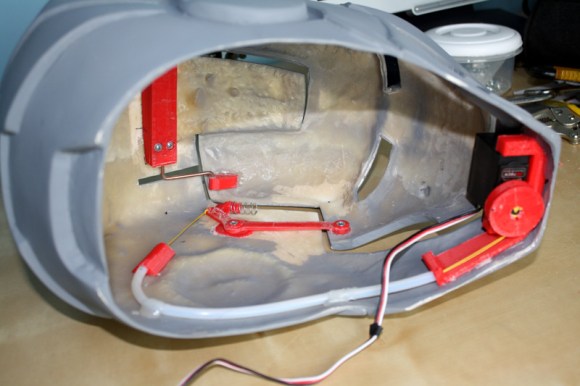
[James] makes some seriously awesome Iron Man props. In one of his latest helmet builds, he came across a handy hack to lock the faceplate servo in place.
You see, as awesome as it is walking around like Iron Man all day, you’re going to want to keep your faceplate up for extended periods of time. Simply holding the servo in place electronically is a waste of power, and results in the annoying sound of a servo under strain. On the other hand, cutting power to it will keep it in place momentarily — but it will also start to close under the force of gravity.
The solution is actually quite simple, by reprogramming the Picaxe-08M microcontroller, the board now shorts the motor terminals to hold it in place. This is called magnetic motor braking, and it works by creating a closed loop that makes it much harder to induce a current under load. We once added this feature to a motorized push-scooter — it’d stop on a dime, although you wouldn’t…
Stick around after the break to see an extremely in depth video on how he setup the entire system.















So in short, he wires the motor terminals together with the NC part of the relay, and the power to the motor on the NO part of the relay. To move the servo, the relay is activated first.
In short? Oh dear…
Clever idea! The relay is set normally-braking, so it shouldn’t use too much idle power.
I wonder whether it would have worked better to run piano wire through the bowden tube instead of string; the servo could push and pull, and he wouldn’t have needed the preload springs that caused this problem in the first place.
Neat technique!
Noted for future reference!
what about n-channel mosfet (protected by parallel diode and serial polyfuse) shorting the motor everytime you disconnect whole servo from power supply?
in other words:
1.) it can be fit inside servo
2.) you can control the braking by disconnecting servo pover supply (well it’s bit problematic as it will probably lead to short-lasting state of short circuit which can damage servo electronics, but there are some workarounds using capacitors, inductors, resistors, polyfuses, diodes, etc… trying to avoid initial current rush)
3.) can’t we use some smaller low-power relay or some tiny solid state device?
there is some possible places you could have an automatic lock.
1. at the servo you could have some kind of cam wheel with a flat spot and an extra lever to go to a notch on the cam that a spring loaded lever could push into to give extra force to prevent external forces from turning it backwards.
2.at the servo put on a smaller cam wheel or connect the draw cable closer to the middle of the cam wheel so it has to force harder to turn it. (the downside is it will raise and lower the lid much faster and could slam it open and closed.
3. at the servo you could add another reduction gear to the servo so it will open and close the lid slower but in reverse it is much more difficult to work the servo with external force (that’s why they say to put your manual shift car in first when parked on a hill and downshifting slows you on a hill and saves your brakes)
4. at the other end of the draw cable you could have a 2 piece lifting lever that works like the locking lever used on some tables
http://cdn3.stanleysupplyservices.com/images/p/448-999.01_s500_p1._Vc60b5c9d_.jpg
connect it so when straight the lid is open and then connect the draw cable to the joint so it can pull it into a V then you will need to add some extra gearing to the servo to make the cable travel further
Power it from the same source as the servo so once you cut power to the servo the brake engages automatically and can’t accidentally be on when you apply power to the servo, else a programming glitch might make the servo-board go poof.
Also a low resistance analog switch would be another good option with multiple options on how you could configure it.
Actually it’s impossible for power to be applied while the terminals are shorted. The relay takes care of that. Programming can only affect the control terminals of the relay, not switching pins.
Given that the servo was able to easily lift the faceplate, it actually sounds like he’s simply driving the servo past what it sees as the end. I’m sure if he backs off the value of the servo it wouldn’t have any problem keeping the faceplate open without a bunch of power use.
Can’t he just use the worm gear to turn the gear that pulls the cable? The worm gear can keep the cable gear from moving.
Ah! My electric lawn mower does this. If you aren’t holding the spring-loaded “safety-handle” the motor shorts, and the blade stops dead. I found that if I release the handle part-way, it cuts the current, but does not short the motor brake, so the blade will coast-down to a stop, instead (which is “unsafe”; because this is the scenario where someone might trip while cutting the grass, going uphill; and the mower rolls back on top of him with the blade spinning – hence the safety mechanism for this specific scenario).
Has anyone got the STL files for this project? I can’t get them from the website!